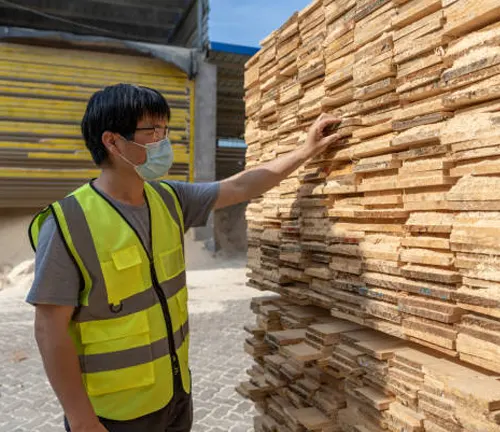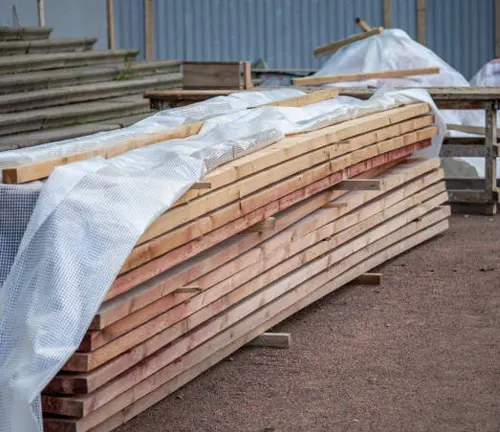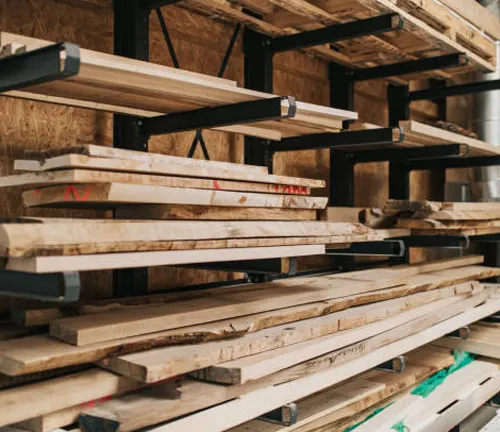How Should Timber Be Stored on Site: Essential Tips for Proper Wood Storage
- September 26, 2024
- 0 comment
Proper timber storage is one of the most important factors in maintaining the quality and integrity of wood on construction sites. Timber, being a natural material, is susceptible to damage if not stored correctly. Moisture, pests, and even sunlight can lead to warping, rotting, or weakening of the wood, which may result in costly repairs or delays. Storing timber on-site requires careful planning and the implementation of best practices.

In this guide, we will cover essential tips to help you store timber effectively, ensuring it remains in optimal condition for use.
Tips for Proper Wood Storage
I. Selecting the Right Storage Location
Choosing a flat, dry, and well-ventilated storage location is critical to keeping timber in good condition. The right location prevents moisture buildup, ensures proper air circulation, and reduces the risk of warping or rotting.
How To Select?
- Choose an elevated or sloped area to ensure water drains away from the timber.
- Ensure the site is flat to prevent timber from warping due to uneven support.
- Select a location with good ventilation to promote airflow around the wood.

Benefits:
- Prevents moisture absorption that could lead to rotting.
- Ensures that the timber remains structurally sound by maintaining even support and ventilation.
II. Ground Protection for Timber
Timber should never be stored directly on the ground, as it is highly susceptible to moisture and pest infestations. Elevating timber off the ground keeps it dry and safe from soil contact.
How to do it?
- Place timber on wooden or plastic pallets, or use pressure-treated sleepers.
- Ensure the timber is elevated at least a few inches off the ground.
- Optionally, place a plastic sheet or tarp under the pallets for additional moisture protection.
Benefits:
- Protects timber from moisture in the soil, reducing the risk of rot.
- Keeps pests, like termites, from easily accessing the wood.
III. Stack Timber Correctly
Correct stacking methods help maintain the timber’s shape and quality. Using spacers allows for even airflow between the boards, promoting uniform drying and preventing warping.
Step-by-Step Guide:
- Stack timber in layers, ensuring each layer is supported by spacers (stickers).
- Place spacers every 18-24 inches along the length of the timber.
- Keep heavier boards at the bottom and lighter ones at the top to avoid crushing.

Benefits:
- Promotes even drying, reducing the risk of warping or cracking.
- Ensures that the timber maintains its structural integrity during storage.
IV. Covering and Protecting Timber from the Elements
Timber should be covered with breathable, waterproof tarps to shield it from rain, snow, and sunlight. However, it’s important to avoid using non-breathable materials that can trap moisture.
Step-by-Step Guide:
- Cover timber stacks with a breathable, waterproof tarp that allows for air circulation.
- Ensure the cover is securely fastened, but leave some space for ventilation to prevent condensation.
- Avoid wrapping the timber too tightly with plastic covers, which can trap moisture.
Benefits:
- Protects the timber from moisture and sunlight damage.
- Allows airflow to prevent condensation, mold, and rot from forming.
V. Regular Inspections and Maintenance
Even with proper storage, timber should be inspected regularly to catch any issues early, such as moisture buildup or pest infestation. Routine maintenance ensures the timber remains in good condition over time.
Step-by-Step Guide:
- Inspect timber weekly for signs of moisture, mold, or pest infestation.
- Use a moisture meter to check the internal moisture levels of the timber.
- Adjust covers or apply pest control treatments as needed based on inspection results.

Benefits:
- Early detection of moisture or pest issues helps prevent widespread damage.
- Ensures timber is in optimal condition for use when needed.
VI. Pest Prevention
Timber is prone to pest infestations, especially termites and wood-boring insects. Preventive measures such as elevating timber and applying pest treatments can help avoid damage.
Step-by-Step Guide:
- Apply pest-resistant treatments, such as borate solutions, to timber before storage.
- Store timber on pallets to reduce contact with the ground, minimizing pest access.
- Keep the storage area clean and free of debris that could attract pests.
Benefits:
- Protects timber from structural damage caused by termites and insects.
- Ensures that timber remains strong and ready for use.
VII. Avoiding Direct Sunlight
Exposure to direct sunlight can cause timber to dry unevenly, leading to cracking, fading, and weakening of the wood. It’s essential to store timber in shaded areas or use UV-resistant covers.
Step-by-Step Guide
- Store timber in a shaded location or under a canopy to block direct sunlight.
- If shade is unavailable, cover the timber with a UV-resistant tarp.
- Ensure there is some airflow to avoid heat buildup under the cover.

Benefits:
- Prevents timber from drying out too quickly, reducing the risk of cracking.
- Maintains the color and strength of the timber by protecting it from UV damage.
VIII. Rotating Stock
To prevent timber from sitting in storage for too long and becoming unusable, it’s important to rotate the stock. This ensures that older timber is used first, preserving its quality.
Step-by-Step Guide:
- Label timber stacks with the date of arrival to track how long they’ve been stored.
- Implement a first-in, first-out (FIFO) system to ensure older timber is used before newer stock.
- Regularly check and rotate timber to ensure even usage across all stock.
Benefits:
- Prevents long-term storage damage such as drying, cracking, or pest infestation.
- Ensures that no timber is wasted due to prolonged storage.
IX. Security Measures for Timber Storage
Timber is valuable and can be targeted for theft or vandalism. Securing timber storage areas with fences, locks, and surveillance ensures it remains safe on-site.
Step-by-Step Guide:
- Store timber in a fenced, lockable area to prevent unauthorized access.
- Install surveillance cameras and lighting around the storage site to deter theft.
- Use locks or chains to secure large bundles of timber.

Benefits:
- Protects timber from theft and vandalism, reducing project delays.
- Ensures the site remains safe and secure.
X. Labeling and Organizing Timber
Proper labeling and organization of timber simplify the retrieval process and ensure that materials are easy to identify. This helps prevent confusion and delays during construction.
Step-by-Step Guide:
- Label timber stacks with the type, size, and date of storage.
- Organize timber by type and size, keeping similar pieces together for easier access.
- Maintain a digital or physical inventory to track timber usage and stock levels.
Benefits:
- Improves site efficiency by making it easier to locate specific timber.
- Ensures that older stock is used before newer material, reducing waste.
Conclusion
Timber should be stored on-site in a dry, level area raised off the ground to prevent it from absorbing moisture. Cover it with a breathable material like a tarp or plastic sheeting to protect it from the weather, while still allowing air circulation. Stack the wood flat and use spacers to keep it stable, straight, and prevent warping. Regularly check the timber for any signs of moisture or damage to maintain its quality.
These steps not only save time and money but also help maintain the integrity of your materials throughout the project.
Frequently Asked Questions (FAQ’s)
- Why is proper timber storage important on-site?
Proper storage prevents timber from being damaged by moisture, pests, and environmental factors, ensuring the wood remains structurally sound and usable for the project. - What is the best location for storing timber on-site?
Timber should be stored in a flat, dry, and well-ventilated area, away from low-lying or water-prone spots. - Why should timber not be placed directly on the ground?
Storing timber on the ground increases the risk of moisture absorption and pest infestations, which can lead to decay and structural weakness. - How should timber be stacked to avoid damage?
Timber should be stacked with spacers (stickers) between layers to allow airflow and prevent warping. Spacers should be placed every 18-24 inches. - How can I protect timber from rain and sun on-site?
Use breathable, waterproof covers like tarps to shield timber from the elements while allowing air circulation to prevent moisture buildup. - How often should I inspect stored timber?
Timber should be inspected regularly for signs of moisture, mold, pests, or physical damage to address issues early and prevent further harm. - What is the first-in, first-out (FIFO) method for timber storage?
The FIFO method involves using the oldest timber in storage first, ensuring that wood doesn’t deteriorate from being stored for too long. - How can I prevent timber theft on construction sites?
Store timber in a secure, fenced-off area, use lockable containers, and ensure the storage area is well-lit and monitored. - How can I prevent pests from damaging stored timber?
Keep timber elevated, away from pest-prone areas, and apply pest-resistant treatments to the wood before storage. - Can sunlight damage timber during storage?
Yes, prolonged exposure to sunlight can cause timber to crack, fade, or dry unevenly, so storing it in shaded areas or under covers is recommended.

Charles Hayes
Forestry AuthorI'm Charles Hayes, I bring over 15 years of specialized expertise in landscaping and woodworking, blending artistic design with sustainable environmental stewardship. My career, fueled by a profound passion for the natural world, encompasses extensive education and hands-on experience in creating harmonious, eco-friendly outdoor spaces and responsibly managing forest resources. Recognized for my professional standing, I am committed to continuous learning and certification in cutting-edge practices. My expertise is not only reflected in my work but also in my contributions to community projects, educational workshops, and collaborations with industry leaders. As an authoritative voice in my field, I strive to share knowledge and promote environmentally conscious approaches, making me a trusted resource in landscaping and forestry.













Leave your comment